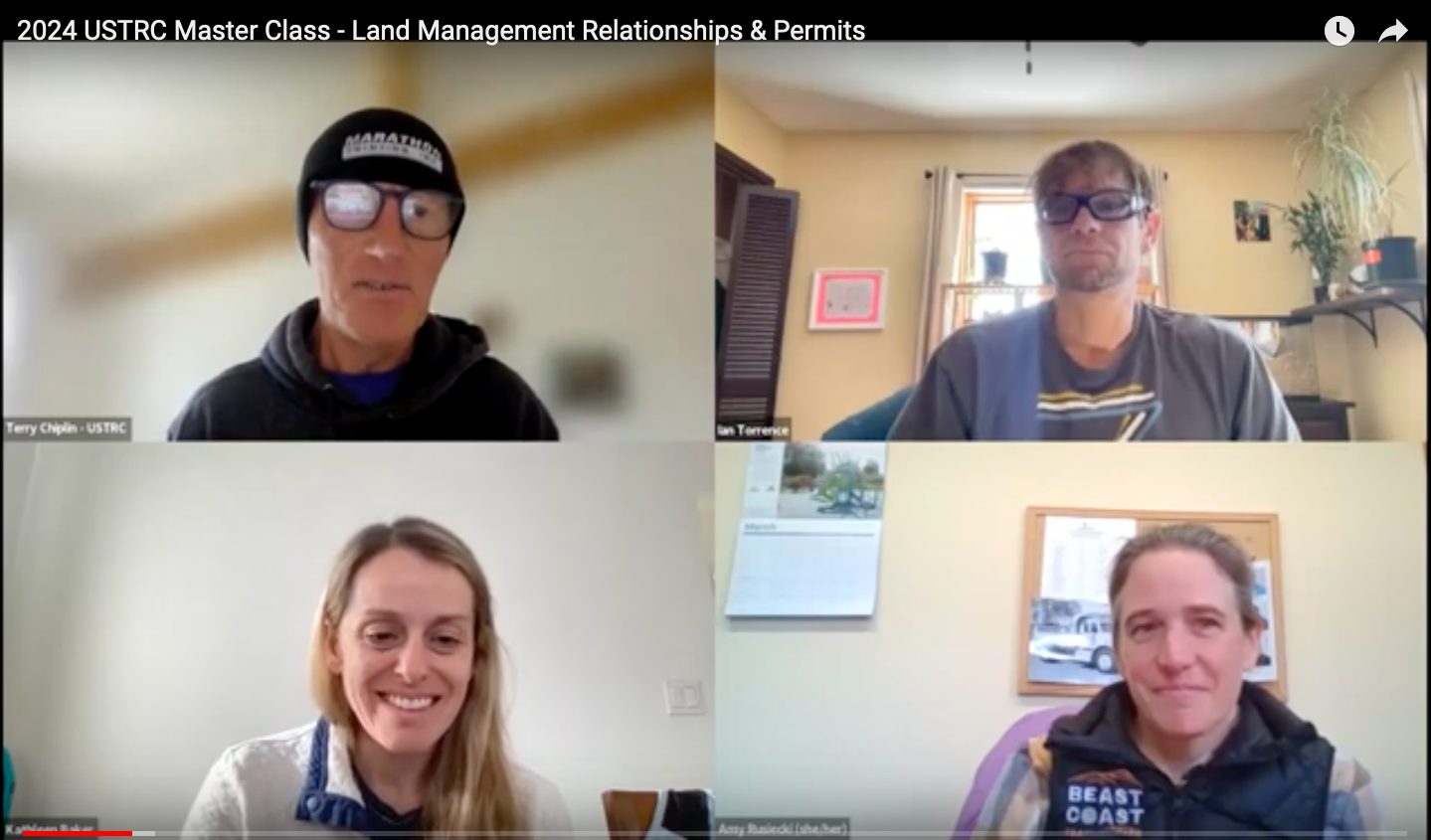US Trail Running Conference Webinar Underscores Land Management and Permitting Challenges
April 4, 2024

Panelists share successful and practical strategies to build lasting relationships with land managers and permitting agencies
/ENDURANCE SPORTSWIRE/ – Mastering Land Management Relationships and Permits was the subject for the third webinar in the nine-webinar RD Master Class series produced by the US Trail Running Conference presented by Marathon Printing, and was live on Tuesday, March 26. The webinar series is free for all race directors and event organizers to access, and is held in partnership with the American Trail Running Association.
This webinar’s panelists featured three race directors that have all faced a variety of challenges when dealing with land management partners and permitting agencies. Kathleen Baker, Managing Director, Runners for Public Lands, Ian Torrence, Stagecoach Line 100 mile Ultra & Relay, and Amy Rusiecki, Vermont 100. Terry Chiplin, founder of the US Trail Running Conference, was the moderator for the session.
Kathleen Baker opened the session by explaining the kinds of lands that trail races are run on. Lands are usually described as Federal, state, local and private. “Runners for Public Lands believes that all lands are Native Lands. We have yet to define the term public lands in a way that reflects our values and is in alignment with traditional Indigenous land ethics.”
Baker went on to describe the role that Runners for Public Lands has in this space. “Runner for Public Lands is the leading advocacy organization representing runners and protecting the environment. What that means is we are working very hard to give runners a seat at that national recreation advocacy table, alongside other organizations…our work focuses on protection of public lands, access to public lands, and climate change policy. All of these are critical to us as runners being able to enjoy the sport we love so much, and as race directors to be able to host runners on the courses that we put together.”
Baker shared a slide that showed her local area, and pointed out that the land on which she runs belongs to the Chumash people. She explained the kinds of advocacy that RPL is involved in on behalf of runners. The first is an act “that would simplify the permitting process for a race that traverses through different types of federal land. In the past you would have to obtain different permits if your race went through forest service and BLM lands…this act would simplify this so you just need one permit, which would be super helpful and reduce the work of race directors. Another exampl;e is the way that forest service charge for their permitting costs. There is a proposal out that would restructure the cost recovery for permits on forest service land, and RPL has been working alongside a number of other organizations, to ensure that the costs aren’t raised for race directors, especially smaller race directors.”
Ian Torrence then shared the route for his race, the Stagecoach Line 100 mile Ultra & Relay, that runs north from Flagstaff towards the Grand Canyon. Ninety percent of the course is on the Arizona Trail; however the race also crosses private lands, and state lands. “In order to eliminate permitting, cost, policy and legality issues, the Arizona Trail has an agreement with a private ranch, so that it completely avoids state lands. We are lucky, Stagecoach only has one permit..we have a permit with the National Forest Service that covers each of the forest service land organizations, who work together to consolidate and save paperwork.”
Torrence went on to say, “The permit is a one pager, that then has an operations and safety plan that you have to submit, so once you have finished with the permit it’s a pretty thick document. Before the race we pay a permit fee, and then after the race we have to disclose the amount of money the event made, and the Forest takes a percentage of that final number. With the nature conservancy and the ranches we have a handshake agreement to run across their land – we supply them insurance just in case anything goes wrong, we have no paperwork, it’s a please clean up after you leave sort of thing.”
Amy Rusiecki said, “I am at the other end of the scale with the Vermont 100….seventy miles of the course is on public dirt roads, so that means that we have to get permission from the nine different towns that we run through, and then sixty to seventy private land owners that have to get permission from..permits and keeping track of permissions from everyone is a super involved process for the Vermont 100.”
Documents for town permissions can range from a twenty page document covering everything, to a note that gives them a heads up that the race is going to happen. “When it comes to organizing a race, it’s a question of understanding what the requirements are for all these different jurisdictions, understanding what the process is, what the timeline is, what the cost impact is. When it comes to the private landowners, there is a group that looks after those landowners, and we reach out to them to get something in writing so that we know that we have permission, and they acknowledge that they have given us permission.”
The panelists presented five key takeaways for race directors or event organizers when it comes to land management relations and permits:
- Identify the Native lands you are running on or across
- Identify the government managed and privately owned lands your event traverses
- Partnership is key to success
- You’ve got this!
- Runners for Public Lands, Rising Hearts, and organizations like the AZ Trail Association heave helpful resources.
Ian Torrence also crafted an in depth feature on land management and race organizations that is an excellent resource for race directors or event organizers:
A trail runner’s primer on public lands.
The session recording is available at the following link: https://youtu.be/m1F8pxVVSsA?si=JpurmXAFWflcxv5-
Active at Altitude, organizers of the US Trail Running Conference and the webinar series, reported 169 participants registered for the session, representing 40 states, as well as Bolivia, Canada, Great Britain, Iceland, Macedonia, Russia and Saudi Arabia. A recording of this webinar is available on the US Trail Running Conference YouTube channel at https://youtu.be/QILWsRQA8_0?si=rIKAk1w2zZ5YGx-r.
The next webinar in the RD Master Class series presented by Marathon Printing is titled: Mastering Racer Information Videos, and takes place on Tuesday, April 23, 2024, from 10.00 a.m. to 11.00 a.m. MST.
Who is this for? Race directors and event organizers who are interested in mastering creating racer information videos as a means to communicate critical race information with race participants. Registration is free – see https://ustrailrunningconference.com/webinar-series/ for more details.
More info:
For details on the US Trail Running Conference and the webinar series, go to https://ustrailrunningconference.com/webinar-series/
Contact Event Director, Terry Chiplin for further information, terry@ustrailrunningconference.com, or + 33 06 79 76 31 53
#TrailConference #trailrunning #visitknoxsports #knoxville #marathonprinting #activeataltitude #atra #TrailConference2024




